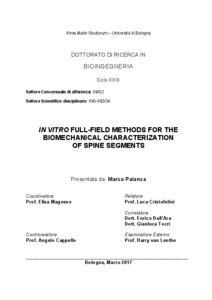Palanca, Marco
(2017)
In Vitro Full-Field Methods for the Biomechanical Characterization of Spine Segments, [Dissertation thesis], Alma Mater Studiorum Università di Bologna.
Dottorato di ricerca in
Bioingegneria, 29 Ciclo. DOI 10.6092/unibo/amsdottorato/8047.
Documenti full-text disponibili:
![[img]](http://amsdottorato.unibo.it/8047/1.hassmallThumbnailVersion/PhDThesis_MarcoPalanca.pdf)  Anteprima |
|
Documento PDF (English)
- Richiede un lettore di PDF come Xpdf o Adobe Acrobat Reader
Disponibile con Licenza: Salvo eventuali più ampie autorizzazioni dell'autore, la tesi può essere liberamente consultata e può essere effettuato il salvataggio e la stampa di una copia per fini strettamente personali di studio, di ricerca e di insegnamento, con espresso divieto di qualunque utilizzo direttamente o indirettamente commerciale. Ogni altro diritto sul materiale è riservato.
Download (43MB)
| Anteprima
|
Abstract
The spine is a complex structure of the human skeleton only partially explored. In the literature, a series of works defined the ranges of motion, the stiffness, the applied loads of physiological, pathological and instrumented spines. The strains instead were evaluated only on vertebrae or intervertebral discs separately. A procedure to study the spine as a whole and in details was missing. The aim of my PhD project was the implementation and improvement of methodologies to quantify the displacement and strain full-field maps, in a contactless way, on spine.
The first part of the project focused on the surface measurement. After a validation and optimization of the Digital Image Correlation, where a systematic error of 10microstrain and a random error of 100microstrain were reached, the know-how was implemented on spine segments. The work showed the feasibility of this procedure and highlighted the potentiality of exploring the spine as a whole and in the details of its organs.
The second part of the research instead focused on the measurement inside the specimen. In this case, the reliability of the Digital Volume Correlation is still challenging and a wide factorial design was planned evaluating the effect of imaging source, tissue type, algorithm, parameters and setting the best compromise between the precision and the measurement spatial resolution. The multifactorial study provided a measurement uncertainty below 200microstrain, useful to explore the strain associated to physiological loads. Finally, this background was moved to explore the strain gradients inside a vertebra in a stepwise loading test, showing, already in the elastic regime, the highest strain region where failure will start.
In conclusion, the project highlighted the importance of a careful validation before using these measurement techniques and confirmed that after optimizing the experimental details it is possible and useful to apply these new procedures on spine.
Abstract
The spine is a complex structure of the human skeleton only partially explored. In the literature, a series of works defined the ranges of motion, the stiffness, the applied loads of physiological, pathological and instrumented spines. The strains instead were evaluated only on vertebrae or intervertebral discs separately. A procedure to study the spine as a whole and in details was missing. The aim of my PhD project was the implementation and improvement of methodologies to quantify the displacement and strain full-field maps, in a contactless way, on spine.
The first part of the project focused on the surface measurement. After a validation and optimization of the Digital Image Correlation, where a systematic error of 10microstrain and a random error of 100microstrain were reached, the know-how was implemented on spine segments. The work showed the feasibility of this procedure and highlighted the potentiality of exploring the spine as a whole and in the details of its organs.
The second part of the research instead focused on the measurement inside the specimen. In this case, the reliability of the Digital Volume Correlation is still challenging and a wide factorial design was planned evaluating the effect of imaging source, tissue type, algorithm, parameters and setting the best compromise between the precision and the measurement spatial resolution. The multifactorial study provided a measurement uncertainty below 200microstrain, useful to explore the strain associated to physiological loads. Finally, this background was moved to explore the strain gradients inside a vertebra in a stepwise loading test, showing, already in the elastic regime, the highest strain region where failure will start.
In conclusion, the project highlighted the importance of a careful validation before using these measurement techniques and confirmed that after optimizing the experimental details it is possible and useful to apply these new procedures on spine.
Tipologia del documento
Tesi di dottorato
Autore
Palanca, Marco
Supervisore
Co-supervisore
Dottorato di ricerca
Ciclo
29
Coordinatore
Settore disciplinare
Settore concorsuale
Parole chiave
Spine, Digital Image Correlation, Digital Volume Correlation, Experimental Stress Analysis, Biomechanics, Vertebra, Intervertebral Discs
URN:NBN
DOI
10.6092/unibo/amsdottorato/8047
Data di discussione
12 Maggio 2017
URI
Altri metadati
Tipologia del documento
Tesi di dottorato
Autore
Palanca, Marco
Supervisore
Co-supervisore
Dottorato di ricerca
Ciclo
29
Coordinatore
Settore disciplinare
Settore concorsuale
Parole chiave
Spine, Digital Image Correlation, Digital Volume Correlation, Experimental Stress Analysis, Biomechanics, Vertebra, Intervertebral Discs
URN:NBN
DOI
10.6092/unibo/amsdottorato/8047
Data di discussione
12 Maggio 2017
URI
Statistica sui download
Gestione del documento:


 Login
Login
